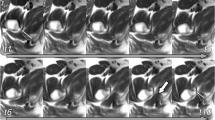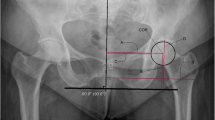Abstract
Objective
To describe femoroacetabular posterior translation (FAPT) using dynamic hip ultrasonography (DHUS), and to determine the inter- and intra-rater reliability of hip ultrasound measurements of FAPT.
Materials and methods
The study design was a feasibility study of 13 healthy young adults (26 hips) using test–retest analysis. The data was collected prospectively over a 2-week time period. Three DHUS measurements (posterior neutral (PN), flexion, adduction, and internal rotation (PFADIR), and stand and load (PStand) were measured by four independent raters (2 senior who divided the cohort, 1 intermediate, 1 junior) at two time points for bilateral hips of each participant. Reliability was assessed by calculating the intraclass correlation coefficient (ICC) along with 95% confidence intervals (CIs) for each rater and across all raters.
Results
A total of 468 US scans were completed. The mean age of the cohort was 25.7 years (SD 5.1 years) and 54% were female. The inter-rater reliability was excellent for PFADIR (ICC 0.85 95% CI 0.76–0.91), good for PN (ICC 0.69 95% CI 0.5–0.81), and good for PStand (ICC 0.72 95% CI 0.55–0.83). The intra-rater reliability for all raters was good for PFADIR (ICC 0.60 95% CI 0.44–0.73), fair for PN (ICC 0.42 95% CI 0.21–0.59), and fair for PStand (ICC 0.42 95% CI 0.22–0.59).
Conclusion
This is the first study to present a protocol using dynamic ultrasonography to measure FAPT. DHUS measure for FAPT was shown to be reliable across raters with varying levels of ultrasound experience.



Similar content being viewed by others
Data availability
The data that support the findings of this study are available from the corresponding author, [HL], upon reasonable request.
References
Kalisvaart MM, Safran MR. Microinstability of the hip–it does exist: etiology, diagnosis and treatment. J Hip Preserv Surg. 2015. https://doi.org/10.1093/jhps/hnv017.
Safran MR. Microinstability of the hip - gaining acceptance. J Am Acad Orthop Surg. 2019. https://doi.org/10.5435/JAAOS-D-17-00664.
Shu B, Safran MR. Hip instability: anatomic and clinical considerations of traumatic and atraumatic instability. Clin Sports Med. 2011. https://doi.org/10.1016/j.csm.2010.12.008.
Harris JD, Gerrie BJ, Varner KE, Lintner DM, McCulloch PC. Radiographic prevalence of dysplasia, cam, and pincer deformities in elite ballet. Am J Sports Med. 2016;44(1):20–7. https://doi.org/10.1177/0363546515601996.
Trentacosta N, Sugimoto D, Micheli LJ. Hip and groin injuries in dancers: a systematic review. Sports Health. 2017;9(5):422–7. https://doi.org/10.1177/1941738117724159.
Skwiot M, Śliwiński G, Milanese S, Śliwiński Z. Hypermobility of joints in dancers. PLoS One. 2019;14(2):0212188. https://doi.org/10.1371/journal.pone.0212188.
Akiyama K, Sakai T, Koyanagi J, Yoshikawa H, Sugamoto K. Evaluation of translation in the normal and dysplastic hip using three-dimensional magnetic resonance imaging and voxel-based registration. Osteoarthr Cartil. 2011;19:6. https://doi.org/10.1016/j.joca.2011.01.017.
Packer JD, et al. Capsular thinning on magnetic resonance arthrography is associated with intra-operative hip joint laxity in women. J Hip Preserv Surg. 2020. https://doi.org/10.1093/jhps/hnaa018.
Packer JD, et al. The cliff sign: a new radiographic sign of hip instability. Orthop J Sport Med. 2018. https://doi.org/10.1177/2325967118807176.
Woodward RM, Vesey RM, Bacon CJ, White SG, Brick MJ, Blankenbaker DG. Microinstability of the hip: a systematic review of the imaging findings. Skeletal Radiol. 2020. https://doi.org/10.1007/s00256-020-03516-7.
Mitchell RJ, et al. Radiographic evidence of hip microinstability in elite ballet. Arthrosc - J Arthrosc Relat Surg. 2016. https://doi.org/10.1016/j.arthro.2015.12.049.
Gilles B, et al. MRI-based assessment of hip joint translations. J Biomech. 2009. https://doi.org/10.1016/j.jbiomech.2009.03.033.
Cvetanovich GL, et al. Assessment of hip translation in vivo in patients with femoracetabular impingement syndrome using 3-dimensional computed tomography. Arthrosc Sport Med Rehabil. 2020. https://doi.org/10.1016/j.asmr.2019.12.002.
Lewis CL, Uemura K, Atkins PR, Lenz AL, Fiorentino NM, Aoki SK, Anderson AE. Patients with cam-type femoroacetabular impingement demonstrate increased change in bone-to-bone distance during walking: a dual fluoroscopy study. J Orthop Res. 2023;41(1):161–9. https://doi.org/10.1002/jor.25332.
D’Hemecourt PA et al. Can dynamic ultrasonography of the hip reliably assess anterior femoral head translation?. 2019. https://doi.org/10.1097/CORR.0000000000000457.
Sahr ME, Endo Y, Sink EL, Miller TT. Dynamic ultrasound assessment of hip instability and anterior and posterior hip impingement. Skeletal Radiol. 2023. https://doi.org/10.1007/s00256-022-04264-6.
Philippon MJ, Kuppersmith DA, Wolff AB, Briggs KK. Arthroscopic findings following traumatic hip dislocation in 14 professional athletes. Arthrosc - J Arthrosc Relat Surg. 2009. https://doi.org/10.1016/j.arthro.2008.09.013.
Krych AJ, Thompson M, Larson CM, Byrd JW, Kelly BT. Is posterior hip instability associated with cam and pincer deformity? Clin Orthop Relat Res. 2012;470(12):3390–7. https://doi.org/10.1007/s11999-012-2468-3.
Novais EN, Ferrer MG, Williams KA, Bixby SD. Acetabular retroversion and decreased posterior coverage are associated with sports-related posterior hip dislocation in adolescents. Clin Orthop Relat Res. 2019;477(5):1101–8. https://doi.org/10.1097/CORR.0000000000000514.
Juul-Kristensen B, Røgind H, Jensen DV, Remvig L. Inter-examiner reproducibility of tests and criteria for generalized joint hypermobility and benign joint hypermobility syndrome. Rheumatology. 2007;46:12. https://doi.org/10.1093/rheumatology/kem290.
Schlager A, et al. Inter- and intra-rater reliability for measurement of range of motion in joints included in three hypermobility assessment methods. BMC Musculoskelet Disord. 2018;19:1. https://doi.org/10.1186/s12891-018-2290-5.
Charter RA. A breakdown of reliability coefficients by test type and reliability method, and the clinical implications of low reliability. J Gen Psychol. 2003. https://doi.org/10.1080/00221300309601160.
Krarup AL, Court-Payen M, Skjoldbye B, Lausten GS. Ultrasonic measurement of the anterior translation in the shoulder joint. J Shoulder Elb Surg. 1999;8:2. https://doi.org/10.1016/s1058-2746(99)90006-x.
Henderson N, Worst H, Decarreau R, Davies G. Ultrasound measurements and objective forces of glenohumeral translations during shoulder accessory passive motion testing in healthy individuals. Int J Sports Phys Ther. 2016;11:5.
Crawford MJ, Dy CJ, Alexander JW, Thompson M, Schroder SJ, Vega CE, Patel RV, Miller AR, McCarthy JC, Lowe WR, Noble PC. The 2007 Frank Stinchfield Award. The biomechanics of the hip labrum and the stability of the hip. Clin Orthop Relat Res. 2007;465:16–22. https://doi.org/10.1097/BLO.0b013e31815b181f.
Dy CJ, Thompson MT, Crawford MJ, Alexander JW, McCarthy JC, Noble PC. Tensile strain in the anterior part of the acetabular labrum during provocative maneuvering of the normal hip. J Bone Jt Surg. 2008;90:7. https://doi.org/10.2106/JBJS.G.00467.
Akiyama K, Sakai T, Koyanagi J, Yoshikawa H, Sugamoto K. In vivo hip joint contact distribution and bony impingement in normal and dysplastic human hips. J Orthop Res. 2013;31:10. https://doi.org/10.1002/jor.22414.
Charbonnier C, et al. Assessment of congruence and impingement of the hip joint in professional ballet dancers: a motion capture study. Am J Sports Med. 2011. https://doi.org/10.1177/0363546510386002.
Bierig SM, Jones A. Accuracy and cost comparison of ultrasound versus alternative imaging modalities, including CT, MR, PET, and angiography. J Diagnostic Med Sonography. 2009;25:3. https://doi.org/10.1177/8756479309336240.
Lentz B, Fong T, Rhyne R, Risko N. A systematic review of the cost-effectiveness of ultrasound in emergency care settings. Ultrasound J. 2021;13:1. https://doi.org/10.1186/s13089-021-00216-8.
Acknowledgements
We would like to extend our appreciation and gratitude to Dr. Young-Jo Kim, Dr. Eduardo Novais, Dr. Travis Matheney, and Dr. Yi-Meng Yen for their contributions on the design of the ultrasound protocol.
Author information
Authors and Affiliations
Corresponding author
Additional information
Publisher's Note
Springer Nature remains neutral with regard to jurisdictional claims in published maps and institutional affiliations.
Rights and permissions
Springer Nature or its licensor (e.g. a society or other partner) holds exclusive rights to this article under a publishing agreement with the author(s) or other rightsholder(s); author self-archiving of the accepted manuscript version of this article is solely governed by the terms of such publishing agreement and applicable law.
About this article
Cite this article
Le, H.M., d’Hemecourt, P.A., Jackson, S.S. et al. Protocol and validity testing of femoroacetabular posterior translation with dynamic hip ultrasonography. Skeletal Radiol 53, 1287–1293 (2024). https://doi.org/10.1007/s00256-024-04560-3
Received:
Revised:
Accepted:
Published:
Issue Date:
DOI: https://doi.org/10.1007/s00256-024-04560-3




